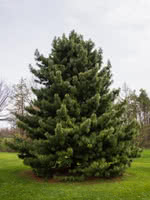Mon-Fri 9am - 5pm Mountain time
Korean Pine vs Japanese Black Pine
Pinus koraiensis
Pinus thunbergii
NOT AVAILABLE THIS SEASON - MIGHT RETURN
NOT AVAILABLE THIS SEASON - MIGHT RETURN
Korean Pine is an attractive conifer suitable for shelterbelts, privacy screens, and ornamental planting. This tree is especially prized for its pine nuts. Korean Pine nuts are larger than most other species. They can be used in salads, pesto sauce, and other foods.
This conifer is generally tolerant of urban conditions but much prefers cool summer climates.
Japanese Black Pine is known for its unique and irregular growth habit, making it a striking landscape addition. It typically does not grow with a central leader. This causes it to form a flat-top, classic bonsai-like shape when mature. When it has a central leader, it will grow with a twisted trunk. Another striking feature is the white apical buds which contrast with the surrounding green needles.
The Japanese Black Pine is an excellent candidate for a bonsai tree and is frequently used by the bonsai community. It is found along the Japanese coast and is salt tolerant.

